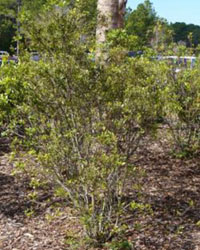Myrica cerifera - Southern wax myrtle, Southern bayberry



Family Myricaceae
Description:
About fifty species of Myrica are native to the Americas, Eurasia and Australia. Some species are associated with nitrogen-fixing bacteria. In nature, it is often found in moist sites in the open or along a woodland edge and will tolerate seasonal flooding. It also grows in disturbed upland sites. Plants are multistemmed and can sucker from the roots. The leaves are aromatic when crushed and are used locally as a mosquito repellent. The leaves are browsed by deer and the waxy fruits are an important wildlife food. The fruit have been used for their wax and fragrance in the manufacture of candles and soaps.
Location:
See these plants in parking lot 2 in front of the library, along the nature trails at Lake Oneida, and in natural areas throughout the region.
Size:
Large shrub or small tree to about fifteen feet tall. Old wild plants may be thirty feet tall.
Care Instructions:
Light: full sun to part shade
Water: drought tolerant once established, may require irrigation in droughts
Soil: average soil, wide pH tolerance, no special requirements
This native shrub is an easy plant to grow throughout Florida. It grows best in a moist, sunny site but is adaptable to a wide range of conditions.
